Tags
acanthus, Anglo-Norman Litany of Saints, April, Boise, border, burnished gold, Cami Nelson, chrysalis, color, Connecticut College, Craig Dworkin, Elizabeth Peterson, eye, Finger Lakes, fragment, France, Geoffrey Babbitt, gilded, gold pavé, gutters, heliotropic, Hobart & William Smith Colleges, Idaho, ink, ivy, Jerry Root, Julie Gonnering Lein, Karen Brennan, Kathryn Cowles, leaf, lift, light, littera gothica textualis, littera gothica textualis formata, Luise Poulton, Marriott Library, National Poetry Month, New York, New York City, Office of the Dead, Paisley Rekdal, Paris, pasture, poet, rare books, rinceaux, scribe, Shira Dentz, Special Collections, Spyten Duyvil, street lamp, tendrils, The University of Utah, thunder, Tom Stillinger, transport, vellum, Vespers, vines
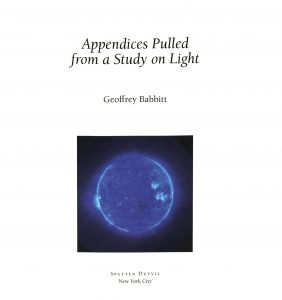
“a trace unnameable — place
holding the child
to the first frost,
the street lamp, the pasture — ”
Appendices Pulled from a Study on Light
Geoffrey Babbitt
New York City: Spuyten Duyvil, 2018
PS3602 A224 A6 2018 (General Collection, Level 2)
“This is Geoffrey Babbitt’s first book. His poems and essays have appeared in North American Review, Pleiades, Colorado Review, DIAGRAM, Notre Dame Review, TYPO, Tarpaulin Sky, The Collagist, Interim, Western Humanities Review, and elsewhere. Raised in Boise, Idaho, he studied at Connecticut College and earned his Ph.D. in creative writing at the University of Utah. Geoffrey currently coedits Seneca Review and teaches at Hobart & William Smith Colleges in the Finger Lakes region of New York, where he lives with poet Kathryn Cowles and their three daughters.”
Geoffrey acknowledges the help of many friends, colleagues and faculty from the University of Utah including Luise Poulton, Karen Brennan, Craig Dworkin, Julie Gonnering Lein, Cami Nelson, Paisley Rekdal, Jerry Root, Tom Stillinger, Shira Dentz, Elizabeth Peterson, and others.
Congratulations, Geoffrey!
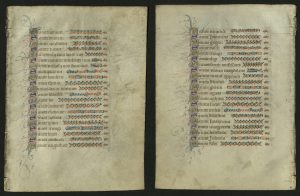
MS Fragment: 4 — Date: ca. 1375 — Origin: France (possibly northeastern) — current location: Marriott Library, University of Utah, Special Collections, Rare Book Division — Materials: Ink, and burnished gold on vellum — Illustration: Detail — Size: 7 1/8 in. x 5 7/16 in. — Section: Anglo-Norman Litany of Saints — Script: littera gothica textualis formata
“vines scritched, chrysalis
onto vellum leaf–all
lost color, stolen thunder
–spiritual curl
of the vine tending
ultimately toward–tattered edge
curling from the gutters…”
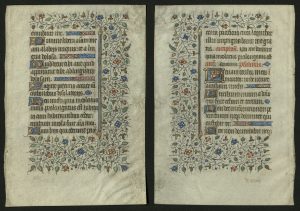
MS Fragment: 8 — Date: ca. 1425-1450 — Origin: France (possibly Paris) — Current Location: Marriott Library, University of Utah, Special Collections, Rare Books Division — Materials: Ink, and burnished gold on vellum — Size: 7 1/4 in. x 5 3/16 in. — Illustration: Detail, border — section: Office of the Dead, Vespers — Script: littera gothica textualis
“lit border
buoys — acanthus
place setting
scribe sets — rinceaux
sprays, gilded ivy leaf,
bryony tendrils, gold pavé
fleur-de-lis — heliotropic
buoyancy — motor cells in
the pulvinus synthesize
bouncing light, con-
vert eye movement, displace
page’s gravitropic
polar auxin transport —
downwarding becomes lift”
April is National Poetry Month.

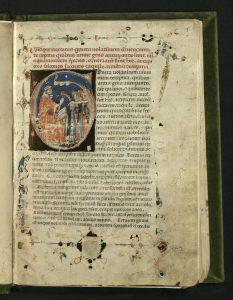
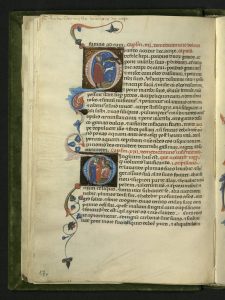
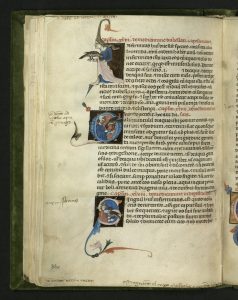
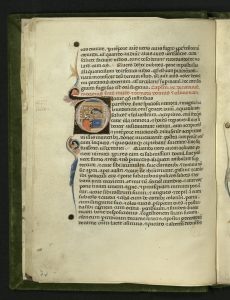

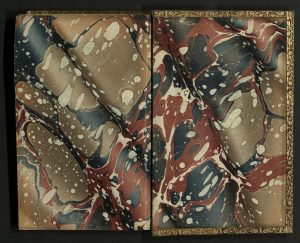
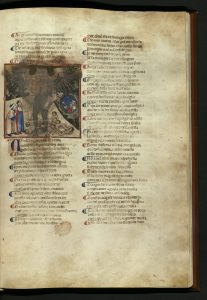
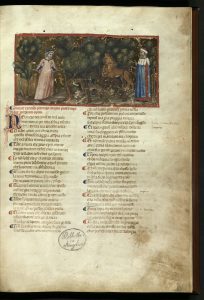
You must be logged in to post a comment.